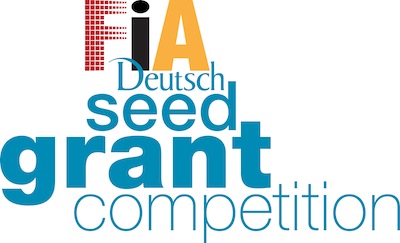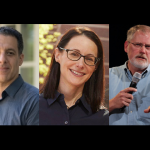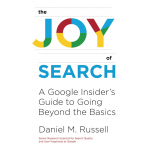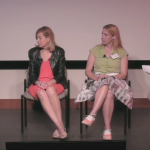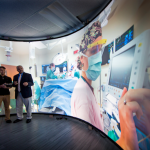Congratulations to the five teams of FIA-Deutsch Seed Grant Competition winners on their inspiring projects!
The FIA-Deutsch Seed Grant Competition winners presented their final presentations on April 23, 2014. Members of four of the teams were named FIA-Deutsch Seed Grant Fellows and shared up to $25,000 per team in stipends and expenses to carry out projects aimed at a variety of information challenges and opportunities. The members of one other team were designated as FIA-Deutsch Seed Grant Honorees and received up to $3,000 for expenses.
Altogether, these five teams included 22 students and six faculty mentors from 9 UMD colleges and schools: Agriculture and Natural Resources; Arts and Humanities; Behavioral and Social Sciences; Computer, Mathematical and Natural Sciences; Engineering; Information; Journalism; Public Health; and Public Policy.
The teams consulted with six of the FIA’s Founding Partners during the course of their work, including: Sesame Workshop; the National Geographic Society, the Library of Congress; the National Archives; the Smithsonian Institution; and the Office of the Governor of Maryland.
Text Message Innovation for Promoting Family Physical Activity among Parents and Their Preschoolers
- Erica Doxzen, School of Public Health
- Irina Iles, Department of Communication, College of Arts and Humanities
- Sarah Pomerantz, School of Public Health
- Dr. Linda Aldoory, School of Public Health (Faculty Mentor)
Final Presentation Video | Slides
Although family physical activity has the potential to help combat childhood obesity and enhance parent-child relationships, many families struggle to incorporate activity into their everyday routines. Our project sought to address this issue by leveraging mobile text messaging, allowing us to reach parents in their everyday lives with interactive, tailored information about family physical activity. Drawing from Social Cognitive Theory, health literacy, cultural competency, and user-centered design, we developed and evaluated a week long pilot of two-way text messages for parents of preschoolers through focus groups and in-depth interviews. We found that parents were very accepting and enthusiastic about receiving interactive texts for family physical activity, and that message tailoring was a feasible and appropriate strategy for addressing barriers to increasing active living. Our message library serves as a “proof of concept” that can be expanded to meet the needs of diverse families and help to close the digital divide.
Locating People in the Past: Creating New Geographic and Historic Knowledge by Embedding the United States Census within Historic Maps
- Clio Grillakis, School of Public Policy / College of Arts and Humanities / College of Behavioral and Social Sciences
- Beth Pruitt, College of Behavioral and Social Sciences
- Benjamin A. Skolnik, College of Behavioral and Social Sciences
- Marcella Stranieri, College of Arts and Humanities
- Stefan Woehlke, College of Behavioral and Social Sciences
- Dr. Mark P. Leone, College of Behavioral and Social Sciences (Faculty Mentor)
Final Presentation Video | Slides | Website
Fundamentally, Locating People in the Past is about combining existing historical datasets to create new information about the past. Using Geographical Information Systems (GIS), we have been able to take the spatial information contained within two historic maps of Talbot County, Maryland dating to the mid-Nineteenth-Century and embed within it the demographic information contained within two corresponding historic United States Censuses for the county. Through this process, we are able to characterize historical demographic distributions both before and after the Civil War and Emancipation, as well as locate specific people in time and in space, people who otherwise may be largely invisible to traditional historical research. In the context of our ongoing research in Talbot County, this is especially important because it allows us to put back onto the landscape the enslaved and newly-freed African Americans who have largely been left out of traditional histories; however, this work has many other applications. In order to make this work available and useful to others, we have created a website along with an interactive online map, which can be found at: aia.umd.edu/locate/. We hope that this process can be used by others elsewhere to create new historic knowledge.
Re-imaging and Re-imagining Choreometrics
- Christina Banalopoulou, School of Theatre, Dance, and Performance Studies
- Andrew Barker, College of Information
- Sargoon Nepaul, Department of Biology, College of Computer, Mathematics, and Natural Sciences
- Emma Sessions, School of Public Health
- Kate Spanos, School of Theatre, Dance, and Performance Studies
- Dr. Karen K. Bradley, School of Theatre, Dance, and Performance Studies (Faculty Mentor)
Final Presentation Video | Slides
This team reimagines the ways in which the 2138 film clips of dances from around the world that comprise the Lomax collection at the Library of Congress could be digitized, marked up, analyzed, cross-referenced, and made accessible to the public. They are developing a wiki site to provide information on the films clips, the Choreometrics project, and the ways in which scholars might access the rich information contained within the collection.
Research Impact Quotient (Research IQ): Designing a Dashboard to Track How Grant Funding Translates into Knowledge
- Zahra Ashktorab, College of Information
- Nicholas Duchesne, Philip Merrill College of Journalism
- Amir Kashanipour, Department of Mechanical Engineering
- Joanna Nurmis, Philip Merrill College of Journalism
- Dr. Sarah Oates, Philip Merrill College of Journalism (Faculty Mentor)
Final Presentation Video | Slides
Research Impact Quotient (ResearchIQ) is a model for a computer dashboard that allows research organizations to see the impact of their grant projects in academic, traditional media, and social media spheres. Partnering with the National Geographic Society, the group used a sample of grant projects funded by the society to design how to mine data from online sources and collate it into a score for each of the three spheres. The tool is designed to reflect the impact measurement needs of research funders such as National Geographic, which would like to better see how the work of their grantees has an impact in the world. ResearchIQ is concerned with how an institution’s research identity is projected into academic and societal ways of thinking about the world. The project developed a model of the tool and explored a range of different ways to capture impact measurements from online data.
FIA-Deutsch Seed Grant Honorees:
Empower Ecuador – Assessing Water Needs for Social Justice
- Jessica Belt, Civil Engineering Department, Clark School of Engineering
- Stephanie Ingber, College of Agriculture and Natural Resources
- Lorena Kowalewski, College of Behavior and Social Sciences
- Julia Nagy, College of Behavior and Social Sciences
- Ian Reichardt, Department of Communication; Colleges of Arts and Humanities / College of Computer, Mathematical and Natural Sciences
- Dr. John Lea-Cox, Plant Science and Landscape Architecture / College of Agriculture and Natural Resources (Faculty Mentor)
- Bruk Belayneh, Plant Science and Landscape Architecture / College of Agriculture and Natural Resources (Faculty Mentor)
Final Presentation Video | Slides
The team traveled to Ecuador in the winter term of 2014 to assess water needs of the Dulcepamba watershed within the Bolivar province of Ecuador. Four internet-enabled weather stations were installed to determine daily water needs of the major crops based on real-time weather. The team has integrated GIS crop maps with crop water use models to estimate crop water demand of the entire watershed. They have also completed surveys of the residents and farmers to determine the average agricultural income of Dulcepamba. This provides both social and economic data for future analysis of the impact of the hydroelectric project on crop production. The Empower Ecuador website is built to disseminate weekly crop water use, precipitation and irrigation needs to residents of the watershed. With a better understanding of irrigation water needs and water availability information, farmers will have the concrete data necessary to collectively apply for water rights in the face of the hydroelectric project’s concession.
Videos by Amanda Salvucci and Ben Susman

